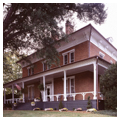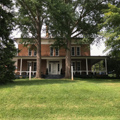When Robert E. Lee came to Washington College to serve as its president in 1865, he first lived in an 1841 faculty house, but it proved too small for his family. In 1867, the Board of Trustees approved a plan for a new building and hired Oltmanns, an “architectural modeler” at VMI, as the architect. Local lending library records show that Oltmanns checked out John Ritch's American Architect (1857), a popular house pattern book, to help him with the plans. Ritch's designs were noted for their “cheapness,” a characteristic that must have appealed to the school. The basic center-passage, double-pile, hipped-roof form was elaborated with heavy coupled brackets under the overhanging eaves, and modillions along its three-sided porch. For all the aim at economy, the Lee House was considered to be a very “fine house” in its day. The building has continued to serve as the university president's house.
You are here
Lee House
If SAH Archipedia has been useful to you, please consider supporting it.
SAH Archipedia tells the story of the United States through its buildings, landscapes, and cities. This freely available resource empowers the public with authoritative knowledge that deepens their understanding and appreciation of the built environment. But the Society of Architectural Historians, which created SAH Archipedia with University of Virginia Press, needs your support to maintain the high-caliber research, writing, photography, cartography, editing, design, and programming that make SAH Archipedia a trusted online resource available to all who value the history of place, heritage tourism, and learning.


























